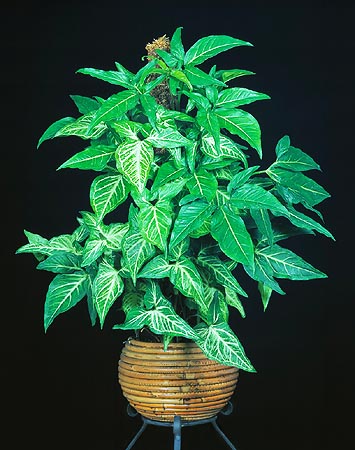Family : Araceae

Text © Pietro Puccio

English translation by Mario Beltramini

The most diffused of the genus. Also indoor © Giuseppe Mazza
The name of genus comes from the combination of the Greek wordings “syn” = with, and “goné” = gonad, with reference to the united ovaries; the name of the species is the combination of the Greek words “pus, podos” = foot, and “phyllon” = leaf.
Common names: “singonio” (Italian); “arrowhead plant”, “arrowhead vine”, “arrowhead philodendron”, “goosefoot”, “trileaf wonder”, “African evergreen” (English); “syngonium”, “pointe de flèche”, “patte d’oie” (French); “singônio” (Portuguese); “singonio”, “planta cabeza de flecha”, “garrobo” (Spanish); “Purpurtute”, “Eselskopf” (German).
Perennial evergreen climber, with a milky sap, with stems rooting at the nodes, which presents the phenomenon of the heterophylly (presence on the same plant of leaves of more than one form), when the plant develops at the level of the soil, it presents sagittate leaves of a dark green colour on the upper page, pale on the lower one, 8-20 cm long and petioles long up to 40 cm, as soon as it finds a support, trees or rocks, on which it can climb, sticking with the aerial roots, the leaves become pedate (leaves where the lamina has two main nervations, each one endowed of lobes only towards the exterior), divided usually into 5-9 lobes, the middle one, ovate, long up to about 25 cm and 6-12 broad, and at this stage the plant enters the reproductive stage.
The axillar inflorescences, usually grouped by 3-9 units, are formed by a white spadix, about 8 cm long, surrounded by a spathe, closed and bulb-shaped in the lower part for about 5 cm of length, of a greenish colour tending to red when the fruits ripe, open and ephemeral in the upper part for a length of about 6-7 cm, of a cream colour.
The flowers are unisexual and protogynous (the female flowers are receptive before the ripening of the male ones, thus avoiding the self fertilization), particularly, the male flowers occupy the upper section of the spadix, the female ones are grouped in the lower part, separated from the male by a thin sterile zone about 1 cm long.
The single fruits are united, forming a collective ovoid fruit (syncarp), about 5 cm long, containing several ovoid seeds of about 8 mm of length, submerged in a white pulp. Usually, it reproduces by portion of stem, by seed, and, industrially, by micro propagation in vitro.
It is the most spread plant of this genus, particularly in its numerous varieties with white, cream or yellow variegated leaf, cultivable in open spaces in tropical and humid subtropical regions, where it is often utilized for covering the ground, or rocks and walls, where it adheres thanks to its aerial roots, in shaded areas.
Elsewhere, it is cultivable in pot, and as such, is one of the most appreciated plants for indoor decoration, on a substratum rich of organic substance, porous and well drained; it adapts to shaded areas, even if the varieties with variegated leaf take advantage from a luminous position, but in any case, far away from the direct sun.
The temperature must be kept over 14-16°C, best around 20-22°C. Watering must be frequent in summer and reduced in winter, thus to always avoid water stagnations which can originate rottenness.
All parts of the plant contain toxic substances, in particular, calcium oxalate, which can cause reactions, even serious, if chewed and swallowed.
Synonyms: Syngonium podophyllum var. typicum Engl. (1920).
